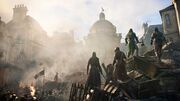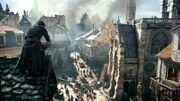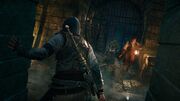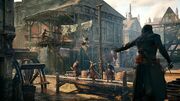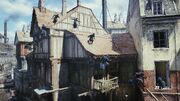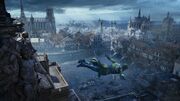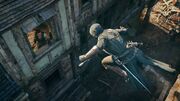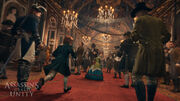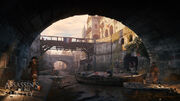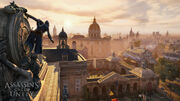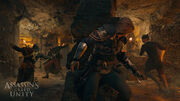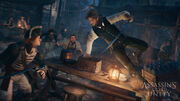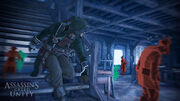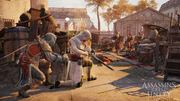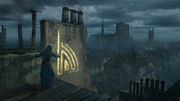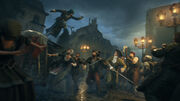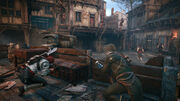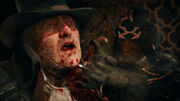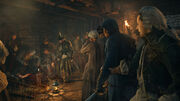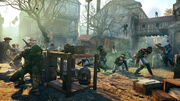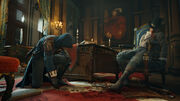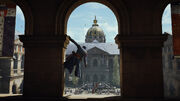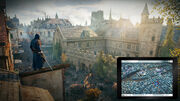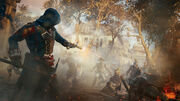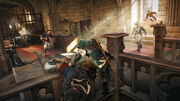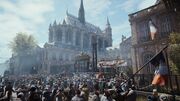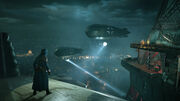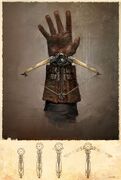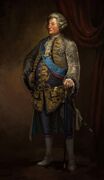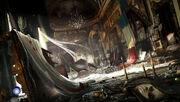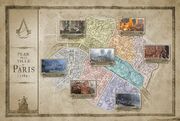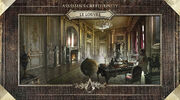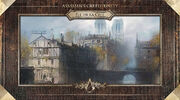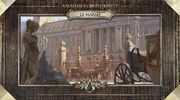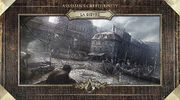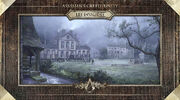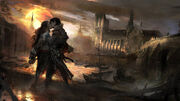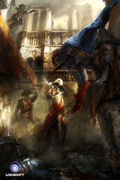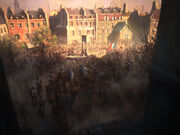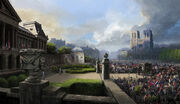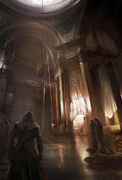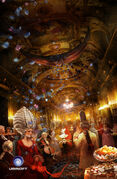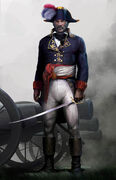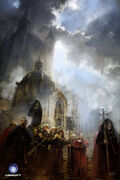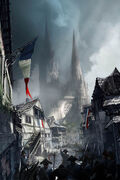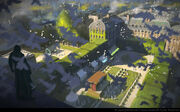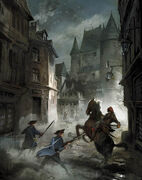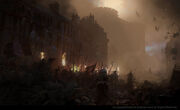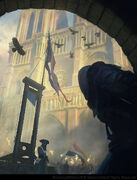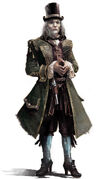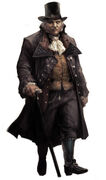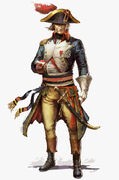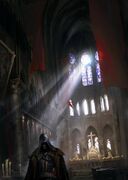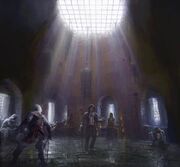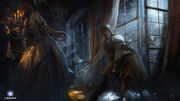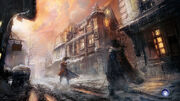(taken from Wiki. Feel free to make changes) |
|||
| Line 19: | Line 19: | ||
''Assassin's Creed: Unity'' is set primarily in [[Paris]] during the [[French Revolution]] in the late 18th century, with two additional areas in [[Versailles]] and [[Saint-Denis]]. |
''Assassin's Creed: Unity'' is set primarily in [[Paris]] during the [[French Revolution]] in the late 18th century, with two additional areas in [[Versailles]] and [[Saint-Denis]]. |
||
| + | |||
| + | ==Plot== |
||
| + | The story begins with the player playing through a memory of the sacking of the Paris Temple, and the capture of Templar Grand Master Jacques de Molay, in 1307. During the sack, de Molay entrusts another Templar with a sword and a book, which the Templar hides within a French crypt shortly before being killed by an Assassin. The memory then fast forwards to de Molay's death at the stake, and his curse towards King Phillip IV and Pope Clement V. |
||
| + | |||
| + | At this point, Bishop from the Assassin Brotherhood hijacks the memory sequence and implores the player to join them as an initiate. Bishop provides an internal Abstergo video memo, in which Abstergo describes the capture of a Sage who contains precursor DNA (which is in a triple–rather than a double–helix). Abstergo goes into detail regarding the Phoenix Project, whereby Abstergo hopes to use the Sage to compile a whole precursor genome for unclear purposes. Bishop provides access to another memory segment and directs the new initiate to locate another Sage, whose corpse they hope to recover. |
||
| + | |||
| + | The memory then segues to Versailles in 1776, as Arno Dorian, a French nobleman's son, meets Elise De La Serre, daughter of the Templar Grand Master. After his father is murdered at the palace, the Grand Master De La Serre adopts Arno despite knowing his father was an Assassin; information to which Arno is oblivious. The story then skips forward 13 years, to Elise's initiation into the Templar order in 1789. Arno is given a message to deliver to Msr. De La Serre, but puts it in his office in order to sneak into the party to meet with Elise. After meeting her, Arno sneaks out, and finds Msr. De La Serre murdered in a courtyard. Arno, mistaken to be De La Serre's killer, is captured by the gendarmerie and imprisoned in the Bastille. There, he finds apocalyptic writings on the wall and impresses a fellow prisoner, the Assassin Pierre Bellec, with his fighting skills. Bellec invites Arno into the Brotherhood when they escape during the Storming of the Bastille. |
||
| + | |||
| + | Arno returns home first and is turned away by Elise, who reveals that the message Arno was supposed to deliver to her father was a warning of his impending murder, and reveals herself as a Templar. Arno joins the Brotherhood and begs for the opportunity to find and eliminate the other Templars involved in De La Serre's death, including Le Roi des Thunes ("The King of Beggars"). He is granted his request by Mirabeau, who was attempting to broker peace between the Orders with De La Serre. During the course of his investigation, Arno rescues François-Thomas Germain, a silversmith being held hostage by the Templar Grand Master Lafreniere. After killing Lafreniere, who was actually the one trying to warn De La Serre, Arno runs into Elise and realizes that Germain is the Sage, as well as the one who ordered De La Serre's murder. The Brotherhood Council begins to question Arno's loyalty as he acts rashly in his pursuit of De La Serre's killer. |
||
| + | |||
| + | Realizing that Germain's plot is intended to spark a mass revolt against the King of France, Arno assassinates two more central figures, an officer organizing a prisoner revolt (Captain Frederic Rouille) and another who was hoarding food (merchant Marie Levesque) to create the impression that the nobility was squandering resources as France starved. Arno also crosses paths with Napoleon Bonaparte, an artillery officer, while searching the Tuileries Palace for letters from the leader of the Assassins, Mirabeau, to King Louis, which the Templars could use as an excuse to purge the Assassins' agents across France. Bonaparte later helped him in taking down Captain Rouille, who served under his command during the September Massacres of September 1792. During this time, Arno saves Elise and convinces her to parley with the Brotherhood, as she confesses her own faction of the Templars are being killed by a schism led by the Sage. Mirabeau agrees, hoping to gain a massive favor from the potential future Grand Master of the Templars, and is murdered by Bellec, who intends to purge the Assassin leadership for beginning to agree with Templar beliefs. Refusing to join him, Arno kills Bellec, and escapes from the food riots and the assassination of Levesque shortly thereafter with Elise in a hot air balloon, after which Arno confesses to Elise that he still loves her. |
||
| + | |||
| + | With the Revolution in full swing, Arno tracks Germain to the execution of King Louis XVI, but chooses to stay and protect Elise rather than pursue him. Elise rejects him for the decision, and Arno is exiled from the Brotherhood for ignoring orders to pursue his personal vendetta, causing him to fall into a drunken depression. Arno languishes for several months before he is found in Versailles by Elise who convinces him to return as Paris is tearing itself apart during the Reign of Terror. Arno returns to Paris and, with Elise's help, discredits the reputation of Maximilien de Robespierre, whom Germain, now Grand Master of the Templars, had placed in charge of maintaining chaos during the Revolution. After Arno and Elise find Robespierre, who had locked himself in his office in an attempt to avoid arrest, Elise shoots Robespierre in the jaw and makes him write down the location of Germain. |
||
| + | |||
| + | Arno confronts Germain at the top of the Temple, only to find he now has the Sword of Eden. The fight eventually ends in the same Templar crypt in which the game began, where Arno strikes Germain only to have the Sword blow him backwards and trap him under rubble. Elise first attempts to help Arno out of the rubble then goes ahead to take on Germain by herself, but as Arno gets the rubble off of him and runs to protect Elise the Sword explodes, killing Elise and mortally wounding Germain. Arno then kills Germain, who in his memories confirms he is the Sage and that he wanted to purge the Templar Order of all who had forgotten the teachings of de Molay. |
||
| + | |||
| + | The game closes with Arno explaining how his understanding of the Creed has changed, and promising to watch over Paris and keep Elise's memory alive. Years later, Arno, having become a Master Assassin, recovers Germain's skeleton from the Temple and places it in the Catacombs of Paris, much to the relief of the Initiate's Assassin handler Bishop, who is now confident that Abstergo will not be able to find it. |
||
==Development== |
==Development== |
||
Revision as of 22:26, 30 December 2017
- "It is sometimes hard to remember how easy life was, before the world changed. Now people are starving in the streets and those with the will to fight back are imprisoned... or worse. The life I had is gone. The world I knew with it. Amongst the violence, amongst the chaos, I will find justice no matter the cost. If we've been betrayed from within, I have to do this myself."
- ―Arno Dorian, Assassin's Creed: Unity Story Trailer.
Assassin's Creed: Unity is a 2014 sandbox action adventure game, and a sequel to 2013's Assassin's Creed IV: Black Flag, the game has the player take on the role of an Initiate as they explore the story of Arno Dorian, who joins the Assassins to investigate the murder of his adoptive father on behalf of his adoptive sister Élise de la Serre, a member of the Templars.
The game was released on 11 November 2014 in North America, 13 November in Europe and 14 November in the UK. It is available for PlayStation 4, Xbox One, and PC.[2]
Assassin's Creed: Unity is set primarily in Paris during the French Revolution in the late 18th century, with two additional areas in Versailles and Saint-Denis.
Plot
The story begins with the player playing through a memory of the sacking of the Paris Temple, and the capture of Templar Grand Master Jacques de Molay, in 1307. During the sack, de Molay entrusts another Templar with a sword and a book, which the Templar hides within a French crypt shortly before being killed by an Assassin. The memory then fast forwards to de Molay's death at the stake, and his curse towards King Phillip IV and Pope Clement V.
At this point, Bishop from the Assassin Brotherhood hijacks the memory sequence and implores the player to join them as an initiate. Bishop provides an internal Abstergo video memo, in which Abstergo describes the capture of a Sage who contains precursor DNA (which is in a triple–rather than a double–helix). Abstergo goes into detail regarding the Phoenix Project, whereby Abstergo hopes to use the Sage to compile a whole precursor genome for unclear purposes. Bishop provides access to another memory segment and directs the new initiate to locate another Sage, whose corpse they hope to recover.
The memory then segues to Versailles in 1776, as Arno Dorian, a French nobleman's son, meets Elise De La Serre, daughter of the Templar Grand Master. After his father is murdered at the palace, the Grand Master De La Serre adopts Arno despite knowing his father was an Assassin; information to which Arno is oblivious. The story then skips forward 13 years, to Elise's initiation into the Templar order in 1789. Arno is given a message to deliver to Msr. De La Serre, but puts it in his office in order to sneak into the party to meet with Elise. After meeting her, Arno sneaks out, and finds Msr. De La Serre murdered in a courtyard. Arno, mistaken to be De La Serre's killer, is captured by the gendarmerie and imprisoned in the Bastille. There, he finds apocalyptic writings on the wall and impresses a fellow prisoner, the Assassin Pierre Bellec, with his fighting skills. Bellec invites Arno into the Brotherhood when they escape during the Storming of the Bastille.
Arno returns home first and is turned away by Elise, who reveals that the message Arno was supposed to deliver to her father was a warning of his impending murder, and reveals herself as a Templar. Arno joins the Brotherhood and begs for the opportunity to find and eliminate the other Templars involved in De La Serre's death, including Le Roi des Thunes ("The King of Beggars"). He is granted his request by Mirabeau, who was attempting to broker peace between the Orders with De La Serre. During the course of his investigation, Arno rescues François-Thomas Germain, a silversmith being held hostage by the Templar Grand Master Lafreniere. After killing Lafreniere, who was actually the one trying to warn De La Serre, Arno runs into Elise and realizes that Germain is the Sage, as well as the one who ordered De La Serre's murder. The Brotherhood Council begins to question Arno's loyalty as he acts rashly in his pursuit of De La Serre's killer.
Realizing that Germain's plot is intended to spark a mass revolt against the King of France, Arno assassinates two more central figures, an officer organizing a prisoner revolt (Captain Frederic Rouille) and another who was hoarding food (merchant Marie Levesque) to create the impression that the nobility was squandering resources as France starved. Arno also crosses paths with Napoleon Bonaparte, an artillery officer, while searching the Tuileries Palace for letters from the leader of the Assassins, Mirabeau, to King Louis, which the Templars could use as an excuse to purge the Assassins' agents across France. Bonaparte later helped him in taking down Captain Rouille, who served under his command during the September Massacres of September 1792. During this time, Arno saves Elise and convinces her to parley with the Brotherhood, as she confesses her own faction of the Templars are being killed by a schism led by the Sage. Mirabeau agrees, hoping to gain a massive favor from the potential future Grand Master of the Templars, and is murdered by Bellec, who intends to purge the Assassin leadership for beginning to agree with Templar beliefs. Refusing to join him, Arno kills Bellec, and escapes from the food riots and the assassination of Levesque shortly thereafter with Elise in a hot air balloon, after which Arno confesses to Elise that he still loves her.
With the Revolution in full swing, Arno tracks Germain to the execution of King Louis XVI, but chooses to stay and protect Elise rather than pursue him. Elise rejects him for the decision, and Arno is exiled from the Brotherhood for ignoring orders to pursue his personal vendetta, causing him to fall into a drunken depression. Arno languishes for several months before he is found in Versailles by Elise who convinces him to return as Paris is tearing itself apart during the Reign of Terror. Arno returns to Paris and, with Elise's help, discredits the reputation of Maximilien de Robespierre, whom Germain, now Grand Master of the Templars, had placed in charge of maintaining chaos during the Revolution. After Arno and Elise find Robespierre, who had locked himself in his office in an attempt to avoid arrest, Elise shoots Robespierre in the jaw and makes him write down the location of Germain.
Arno confronts Germain at the top of the Temple, only to find he now has the Sword of Eden. The fight eventually ends in the same Templar crypt in which the game began, where Arno strikes Germain only to have the Sword blow him backwards and trap him under rubble. Elise first attempts to help Arno out of the rubble then goes ahead to take on Germain by herself, but as Arno gets the rubble off of him and runs to protect Elise the Sword explodes, killing Elise and mortally wounding Germain. Arno then kills Germain, who in his memories confirms he is the Sage and that he wanted to purge the Templar Order of all who had forgotten the teachings of de Molay.
The game closes with Arno explaining how his understanding of the Creed has changed, and promising to watch over Paris and keep Elise's memory alive. Years later, Arno, having become a Master Assassin, recovers Germain's skeleton from the Temple and places it in the Catacombs of Paris, much to the relief of the Initiate's Assassin handler Bishop, who is now confident that Abstergo will not be able to find it.
Development
Assassin's Creed: Unity began development in 2010 as Assassin's Creed: Brotherhood wrapped up development.[3] Ubisoft's Montreal-based team, in conjunction with nine other studios from Toronto, Kiev, Singapore, Shanghai, Annecy, Montpellier, Bucharest, Quebec, and Chengdu worked on the game.[4]
The creative director was Alexandre Amancio, who also served in that capacity on 2011's Assassin's Creed: Revelations. He was offered the French Revolution game before taking the job of creative director on Revelations. After shipping that game, he was exhausted and took a job in advertising before returning to Ubisoft on Unity in June 2012.[5][6]
Amancio aimed to utilize the then next-generation console technology to push the boundaries of storytelling, and having an engaging love story without making it become a secondary storyline. He cited Ico and Passage as video games that successfully placed romance at the center of gameplay, but noted those were far less complex than an Assassin's Creed game.[7]
Travis Stout wrote the single player story, Ceri Young wrote the co-op missions, and Russell Lees scripted the single-player side missions.[8] The historical characters have been mostly relegated to the side missions, leaving Stout to concentrate on writing a story focusing on Arno.[9]
French historian Dr. Jean Clement Martin acted as script consultant. According to the series' primary historical advisor Maxime Durand, he aided in ensuring the story did not feel too Royalist despite critiquing the Revolution.[10]
The game uses a rebuilt Anvil game engine utilizing the Theatre, Zen and City Lights tools, which respectively improve animation, asset management and volumetric lighting.[11] Quebec professor Laurent Turcot advised developers on the look of 18th century Paris, advising them to look at contemporary paintings and engravings in recreating the past. Nicolas-Jean-Baptiste Raguenet's paintings were emulated for the appearance of the city's water.[10]
Unity has crowds numbering in the thousands, with new animations and behaviors, such as holding hands or chatting to each other, enhancing their believability. When Arno sees crowds from a distance, the civilians' animation rigs are simplified, but as he gets closer, their "bones" increase and their behavior becomes more complex.[12]
Amancio explained the game's cast are using English accents because unlike previous games, where accents distinguished characters and reminded players where they are from, it is clear to the player that the characters in Unity are French so using those accents was deemed unnecessary.[13]
Unlike previous installments, Unity is set to have three composers for the soundtrack: Chris Tilton, Ryan Amon and Sarah Schachner.[14]
Gameplay
As the game is exclusive to next-generation consoles and PC, it will enable renderings of Paris to 1:1 scale and crowds numbering in the thousands. Players will able to explore the city's entirety, including seamless interiors and the catacombs of Paris, with landmarks like Notre-Dame having a quarter of the building's interior playable. Even empty buildings may have unlockable rooms with treasures inside.[11][15][16] When standing on rooftops, a button can display 3D objects like alarm bells to help the player strategize.[17]
Haystacks have been largely removed in favor of allowing players to control their descent from rooftops, and the controls for freerunning up and down are now separate.[18] Social Stealth has been improved upon with a special crouching mode activated by button, and combat has been made more tactical to feel more realistic: counter kills were removed.[11]
Assassinations in the game are referred to as "black box missions," and harken to the style of gameplay from the first Assassin's Creed. Contextual clues are provided to allow the player to choose and plan their own approach, rather than follow a linear, pre-determined path to the target. Unlike previous games however, an assassination is not deemed successful until Arno has escaped after performing it.[19]
Memories
For memories, instead of the player being given a series of objectives, Ubisoft has developed the Adaptive Mission Mechanic, which gives players several potential paths to complete a mission. For example, choosing to stalk a target will lead to a chase if they detect you, as opposed to causing desynchronization.[15]
Customization
The Assassins' weapons and appearance are customizable, while experience gained can be spent on four different specialties: "Melee" (offense), "Health" (defense), "Ranged" (navigation), and stealth.[20] For example, Arno can possess Eagle Pulse, which allows him to sense how many guards are in a location he intends to infiltrate. Like other skills, it can be upgraded with experience points at the player's discretion.[21] He can also unlock a disguise skill to escape pursuing guards. The player will be able to upgrade all of Arno's skills, given his objective is to become a Master Assassin.[22]
There are around 200 choices for Arno's gear, which can benefit gameplay:
- Hoods can decrease a guard's reaction time as well as increase the radius of Eagle Sense.
- Chest items refer to the Assassins' robes, which changing can increase the time you can spend blended in the crowd, and the time it takes for a guard to detect you.
- Arm items change the appearance of the Hidden Blade, increasing melee damage and the Phantom Blade's ammunition, but can also increase the time it takes to revive allies.
- Belts and sashes increase the number of health points and items carried.
- Pants and boots can decrease fall damage and running noises, as well as providing extra health.[20]
Cooperative play
- "Assassins do not only embark on their own quests (like Ezio avenging his family), they have to pay their dues to the Assassin council. So players will have to complete what we call Brotherhood missions, in shared experience, to fulfill their duties towards the Assassins."
- ―Alex Amancio discussing the reason behind cooperative gameplay.[[src]]
Following the success of Wolfpack in Assassin's Creed III and Assassin's Creed IV: Black Flag, Assassin's Creed: Unity is the first game in the series to introduce campaign co-op. Up to four players can take on story-based missions including sabotaging an execution, protecting an emperor or assassinating a target.[2] However, the co-op missions will be optional, all story-based, and can be completed singularly as well.[16]
Co-operative gameplay starts at taverns, where the player can see a "ghost" of a friend who is also playing. Approaching said ghost can establish a request to join the friend on their mission, and both will be loaded to the mission's nearest checkpoint.[18] Amancio expects players will spend a third of their time in co-op mode.[11]
Players can unlock skills that will benefit a whole group: these include the Disguise skill, Group Healing, the Assassin Cache for sharing bombs and ammunition, and Communal Sense, which colors targets' locations across the whole map.[23]
There are heist missions for the Assassins to steal money. The more an Assassin is detected, the less money will be gained. Amancio commented that the co-op missions will encourage players to work together, thereby avoiding a session from falling apart with gamers who refuse to co-operate.[22]
Players can also roam around together in open world co-op and do several puzzles together such as the Nostradamus Enigmas
Other
The modern day portion will return, but will differ from the Abstergo Entertainment.[15].[24] It instead uses "Helix" a fictional video game console that allows users to play and view genetic memories. The player themselves is playing as a user who is streaming Arno's memories through the help of Assassins Bishop and Shaun, with Bishop being the person who directly talks to him. They show him a stolen internal Abstergo video that explains scientists discovering rare DNA with triple helix (instead of the normal 2) that are from sages. The video states that if they find enough they could build a memory sequence that shows the locations of the pieces of eden, advanced technology left over from the first civilization. The assassins are looking for the sage that Arno met at some point in his life. At some points in the game there are sever sweeps where Arno has to run into a portal before the user is discovered by Abstergo. He then goes through a linear level of Paris in different years such The Belle Epoqué. and the Second World War. He then has to go through the portal to return to the simulation.[23]
Unity is the first game in the Assassin's Creed series to lack the competitive multiplayer, since its initiation in Brotherhood.[16]
Controversy
The development team had intended for players to choose the co-op characters' gender, but it was abandoned due to time constraints. "It's double the animations, it's double the voices, all that stuff and double the visual assets", Amancio explained. "Especially because we have customizable assassins. It was really a lot of extra production work."[25]
This caused an immediate uproar of anger from many fans of the series. Even Assassin's Creed III animation director Jonathan Cooper criticized this reason, stating, "In my educated opinion, I would estimate this to be a day or two's work. Not a replacement of 8000 animations", explaining "Walk/run cycles and idles are the easiest way to define a character. Everything else is androgynous."[26] He also revealed Aveline de Grandpré shared more animations with Ratonhnhaké:ton than Edward Kenway did.[27]
In response, Ubisoft issued the following statement:
- "Assassin's Creed Unity is focused on the story of the lead character, Arno. Whether playing by yourself or with the co-op shared experiences, you the gamer will always be playing as Arno, complete with his broad range of gear and skill sets that will make you feel unique. With regard to diversity in our playable Assassins, we've featured Aveline, Connor, Adéwalé and Altaïr in Assassin's Creed games and we continue to look at showcasing diverse characters. We look forward to introducing you to some of the strong female characters in Assassin's Creed Unity."
The game shipped with many bugs and glitches, leading Ubisoft to apologize by offering the Dead Kings DLC for free. Later patches stabilized game performance and also allowed players to acquire legacy items without needing the companion app or an account on the Initiates website.
Editions
To date, Ubisoft has announced several collector's editions of Assassin's Creed: Unity. The Gold Edition is no longer available as the Season Pass has been removed.
- A retail copy of Assassin's Creed: Unity.
- A collector's box.
- A replica of Arno's pocket watch.
- An exclusive weapon: the Parade Pistol.
- One exclusive single player mission: The Chemical Revolution.
- A retail copy of Assassin's Creed: Unity.
- A jumbo steel case.
- A copy of the official soundtrack.
- A copy of the official artbook.
- Two lithographs.
- Two exclusive single player missions: Chemical Revolution and American Prisoner.
- A retail copy of Assassin's Creed: Unity.
- A collector's box.
- A copy of the official soundtrack.
- A copy of the official artbook.
- A 16" Arno figurine.
- A music box.
- Two exclusive single player missions: Chemical Revolution and Killed by Science.
- A retail copy of Assassin's Creed: Unity.
- A collector's box.
- A FuturePak case.
- A copy of the official soundtrack.
- A copy of the official artbook.
- A 41cm Arno guillotine figurine.
- A secret Paris map.
- A framed canvas print.
- Two lithographs.
- A customized tarot card game.
- A music box.
- Two exclusive single player missions.
- Exclusive weapons and outfits.
- A retail copy of Assassin's Creed: Unity.
- A collector's box.
- A copy of the official soundtrack.
- A copy of the official artbook.
- A 39.5cm Arno gargoyle figurine.
- Two exclusive single player mission: Chemical Revolution and American Prisoner.
Marketing
For the 2014 San Diego Comic-Con, Ubisoft designed an obstacle course, where parkour experts and stuntmen were on hand to help fans recreate the freerunning moves they will see in the game. An animated trailer debuted there was produced by Rob Zombie, designed by Tony Moore and narrated by Féodor Atkine.[28]
Gallery
Appearances
| Characters | Creatures | Events | Locations | |
| Organizations and titles | Sapient species | Vehicles | Weapons and technology | Miscellanea |
Characters
|
Events
Locations
Organizations and titles
Sapient species
Weapons and technology
References
- ↑ ESRB
- ↑ 2.0 2.1 Assassin's Creed: Unity Official E3 2014 Co-op Commented Demo
- ↑ Vincent Pontbriand's Linkedin page
- ↑ IGN - 10 Ubisoft studios developing Assassin's Creed: Unity
- ↑ GameInformer: From Revelations To Unity: Creative Directing Assassin's Creed
- ↑ Alexandre Amancio's Linkedin page
- ↑ GameInformer: Can Assassin's Creed Unity Pull Off A Love Story?
- ↑ AC Initiates: The Network Podcast - Episode 5
- ↑ Ubisoft YouTube: Amancio SDCC interview
- ↑ 10.0 10.1 Fast Company Co.Create: The (Fun, Violent) History Lesson Inside "Assassin's Creed Unity"
- ↑ 11.0 11.1 11.2 11.3 DualShockers - Assassin’s Creed Unity FAQ Answers All Your Questions about Story, Co-op, Next-Gen Graphics and More
- ↑ GameInformer: Watch The Largest Crowd Assembled In Assassin's Creed Unity
- ↑ YouTube: Assassin's Creed Unity - E3 Story Interview with Alex Amancio (Creative Director)
- ↑ Twitter - Loomer979
- ↑ 15.0 15.1 15.2 UbiBlog - Assassin’s Creed Unity: 9 Things You Need to Know
- ↑ 16.0 16.1 16.2 Kotaku: Assassin's Creed Unity's Paris is Huge. Really Huge.
- ↑ Eurogamer Video: Assassin's Creed Unity's new parkour and combat explored
- ↑ 18.0 18.1 GameInformer - Ten Things You Need To Know About Assassin's Creed Unity
- ↑ Gamespot - How the Assassinations in Assassin's Creed: Unity Encourage Patience and Creativity
- ↑ 20.0 20.1 Gematsu: Assassin’s Creed: Unity Gamescom screenshots
- ↑ IGN Live E3 2014: Assassin's Creed Unity Gameplay Demo
- ↑ 22.0 22.1 GameInformer: Special Edition Podcast – Assassin's Creed Unity
- ↑ 23.0 23.1 Assassin's Creed: Unity 101 trailer
- ↑ Gamestm - Assassin's Creed Unity 'modern day' setting teased
- ↑ Polygon - Ubisoft abandoned women assassins in co-op because of the additional work
- ↑ Twitter - Jonathan Cooper
- ↑ Twitter - Jonathan Cooper: "Aveline de Grandpré shares more of Connor Kenway's animations than Edward Kenway does."
- ↑ Official website: Assassin’s Creed Experience
| |||||||||||||||||||||||||||||||
































